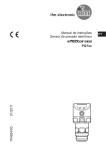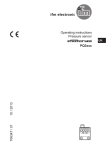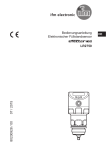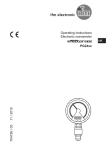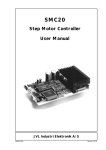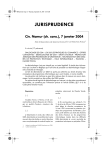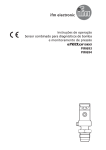Download Operating instructions Electronic pressure
Transcript
Operating instructions Electronic pressure sensor UK 704554 / 00 09 / 2010 PI27xx Contents 1 Preliminary note���������������������������������������������������������������������������������������������������4 1.1 Symbols used������������������������������������������������������������������������������������������������4 2 Safety instructions�����������������������������������������������������������������������������������������������4 3 Functions and features����������������������������������������������������������������������������������������5 3.1 Applications���������������������������������������������������������������������������������������������������5 4 Function���������������������������������������������������������������������������������������������������������������5 4.1 Processing of the measured signals��������������������������������������������������������������5 4.2 Pressure monitoring / switching function�������������������������������������������������������6 4.3 Pressure monitoring / analogue function�������������������������������������������������������6 4.4 Customer-specific calibration������������������������������������������������������������������������8 5 Installation�����������������������������������������������������������������������������������������������������������9 6 Electrical connection������������������������������������������������������������������������������������������10 7 Operating and display elements������������������������������������������������������������������������ 11 8 Menu������������������������������������������������������������������������������������������������������������������12 8.1 Menu structure: main menu�������������������������������������������������������������������������12 8.2 Explanation of the main menu���������������������������������������������������������������������13 8.3 Menu structure: level 2 (extended functions)�����������������������������������������������14 8.4 Explanation of the menu level 2������������������������������������������������������������������15 8.5 Menu structure: level 3 (simulation)�������������������������������������������������������������16 8.6 Explanation of the menu level 3������������������������������������������������������������������17 9 Parameter setting����������������������������������������������������������������������������������������������18 9.1 General parameter setting���������������������������������������������������������������������������18 9.2 Configure display (optional)�������������������������������������������������������������������������20 9.3 Set output signals����������������������������������������������������������������������������������������20 9.3.1 Set output functions����������������������������������������������������������������������������20 9.3.2 Set switching limits����������������������������������������������������������������������������21 9.3.3 Scale analogue value for OUT2���������������������������������������������������������21 9.4 User settings (optional)��������������������������������������������������������������������������������22 9.4.1 Carry out zero point calibration ����������������������������������������������������������22 9.4.2 Set delay for the switching outputs�����������������������������������������������������22 9.4.3 Set switching logic for the switching outputs��������������������������������������22 9.4.4 Set damping for the switching signal��������������������������������������������������22 9.4.5 Set damping for the analogue signal��������������������������������������������������22 9.4.6 Calibrate curve of measured values���������������������������������������������������23 2 9.5 Service functions�����������������������������������������������������������������������������������������24 9.5.1 Read min/max values for system pressure����������������������������������������24 9.5.2 Reset all parameters to factory setting�����������������������������������������������24 9.6 Simulation function��������������������������������������������������������������������������������������24 9.6.1 Open menu level 3 (simulation)����������������������������������������������������������24 9.6.2 Set simulation value���������������������������������������������������������������������������24 9.6.3 Set time for simulation������������������������������������������������������������������������25 9.6.4 Start simulation�����������������������������������������������������������������������������������25 10 Operation���������������������������������������������������������������������������������������������������������25 10.1 Read set parameters���������������������������������������������������������������������������������25 UK 10.2 Change the display in the Run mode ������������������������������������������������������26 10.3 Error indications�����������������������������������������������������������������������������������������26 11 Scale drawing �������������������������������������������������������������������������������������������������27 12 Technical data��������������������������������������������������������������������������������������������������28 12.1 Setting ranges�������������������������������������������������������������������������������������������30 13 Factory setting�������������������������������������������������������������������������������������������������31 3 1 Preliminary note 1.1 Symbols used ► > […] → Instruction Reaction, result Designation of pushbuttons, buttons or indications Cross-reference Important note Non-compliance can result in malfunctions or interference. 2 Safety instructions • Please read this document prior to set-up of the unit. Ensure that the product is suitable for your application without any restrictions. • If the operating instructions or the technical data are not adhered to, personal injury and/or damage to property can occur. • Check the compatibility of the product materials (→ 12 Technical data) with the media to be measured in all applications. For the scope of validity cULus: The device shall be supplied from an isolating transformer having a secondary Listed fuse rated either a) max 5 amps for voltages 0~20 Vrms (0~28.3 Vp) or b) 100/Vp for voltages of 20~30 Vrms (28.3~42.4 Vp). The Sensor shall be connected only by using any R/C (CYJV2) cord, having suitable ratings. 4 3 Functions and features The unit monitors the system pressure in a plant. 3.1 Applications Type of pressure: relative pressure Order no. PI2793 PI2794 PI2795 PI2796 PI2797 PI2799 PI2798 PI2789 Measuring range bar -1...25 -1...10 -1...4 -0.124...2.5 -0.05...1 -1...1 mbar -12.4...250 -5...100 PSI -14.4...362.7 -14.5...145 -14.5...58 -1.8...36.27 -0.73...14.5 -14.5...14.5 PSI -0.18...3.62 -0.073...1.45 Permissible overpressure bar PSI 100 1450 50 725 30 435 20 290 10 145 10 145 bar PSI 10 145 4 58 Bursting pressure bar PSI 350 5075 150 2175 100 1450 50 725 30 435 30 435 bar PSI 30 435 30 435 UK Avoid static and dynamic overpressure exceeding the given overload pressure by taking appropriate measures. The indicated bursting pressure must not be exceeded. Even if the bursting pressure is exceeded only for a short time, the unit may be destroyed. ATTENTION: risk of injury! Not to be used in a system that has to fullfill D10.1.2/74-03 of 3A standard 74-03. 4 Function 4.1 Processing of the measured signals • The unit displays the current system pressure. • It generates 2 output signals according to the parameter setting. OUT1 OUT2 •Switching signal for system pressure limit value. 3 options: •Switching signal for system pressure limit value. •Analogue signal 4...20 mA. •Analogue signal 20...4 mA. 5 4.2 Pressure monitoring / switching function OUTx changes its switching state if it is above or below the set switching limits (SPx, rPx). The following switching functions can be selected: • Hysteresis function / normally open: [OUx] = [Hno] (→ fig. 1). • Hysteresis function / normally closed: [OUx] = [Hnc] (→ fig. 1). First the set point (SPx) is set, then the reset point (rPx) with the requested difference. • Window function / normally open: [OUx] = [Fno] (→ fig. 2). • Window function / normally closed: [OUx] = [Fnc] (→ fig. 2). The width of the window can be set by means of the difference between SPx and rPx. SPx = upper value, rPx = lower value. 1 2 P = system pressure; HY = hysteresis; FE = window 4.3 Pressure monitoring / analogue function The analogue output can be configured. • [OU2] defines whether the set measuring range is provided as 4...20 mA ([OU2] = [I]) or as 20...4 mA ([OU2] = [InEG]). Scaling can be set by means of the teaching process or by entering a value for the ASP and AEP parameters. • Teaching the analogue start point [tASP] or setting the parameter [ASP] defines at which measured value the analogue signal is 4 mA (20 mA at [InEG]). • Teaching the analogue end point [tAEP] or setting the parameter [AEP] defines at which measured value the output signal is 20 mA (4 mA at [InEG]). 6 Minimum distance between [ASP] and [AEP] = 25 % of the final value of the measuring range (turn-down 1:4). Factory setting Measuring range scaled UK P = system pressure, MAW = initial value of the measuring range, MEW = final value of the measuring range 1 : [OU2] = [I]; 2 : [OU2] = [InEG] In the set measuring range the output signal is between 4 and 20 mA ([OU2] = [I]) or between 20 and 4 mA ([OU2] = [InEG]). It is also indicated: • System pressure above the measuring range: -- Output signal > 20 mA at [OU2] = [I]. -- Output signal 3.8 to 4 mA at [OU2] = [InEG]. • System pressure below the measuring range: -- Output signal 3.8 to 4 mA at [OU2] = [I]. -- Output signal > 20 mA at [OU2] = [InEG]. 7 4.4 Customer-specific calibration The customer-specific calibration changes the curve of measured values compared to the real measured values (shifting / change of the gradient; → 9.4.6 [CAL]). • Two calibration points can be defined (CP1, CP2). The two points are independent of each other. • The two calibration points must be within the scaled measuring range (→ 4.3 Pressure monitoring / analogue function) . • The zero point calibration [COF] influences the calibration of the curve of measured values. Recommendation: set [COF] to 0 (→ 9.4.1 [COF]), then calibrate the curve of measured values. After a change the calibration can be reset to factory setting (→ 9.5.2 [rES]). 8 •P = measured pressure; P‘ = modified measured value •CP1 = calibration point 1; CP1‘ = modified measured value for CP1 •CP2 = calibration point 2; CP2‘ = modified measured value for CP2 •1 = curve of measured values at factory setting •2 = curve of measured values after calibration 5 Installation Before installing and removing the unit: make sure that no pressure is applied to the system. Note: display “0%” does not mean that no pressure is applied to the system! We recommend horizontal installation for high medium temperatures. Use in hygienic installation situation following 3A Orientation of the sensor in the pipe and tank To ensure optimised cleanability in the area of the measuring cell according to the sanitary 3A criteria the sensor must not be installed at the lowest point (pos. 5 - see drawing) in a pipe or tank to allow the medium to flow off. UK Use in hygienic areas to EHEDG ►► Make sure that the sensors are integrated into the system in accordance with EHEDG. The unit can be fixed to different process connections. Options are as follows: 1 2 Installation using an adapter with sealing ring (order no. E332xx / E333xx) The adapters are supplied with an EPDM O-ring (order no. E30054). More sealing rings are available as accessories: FKM O-ring (order no. E30123); PEEK sealing ring (order no. E30124). Concerning installation → Installation instructions supplied with the adapter. Installation using an adapter with metal-to-metal seal Order no. E337xx / E338xx Concerning installation → Installation instructions supplied with the adapter. 9 3 4 Installation using a welding adapter •Order no. E30122 •Order no. E30130; adapter with leakage port The adapters are supplied with an EPDM O-ring (order no. E30054). More sealing rings are available as accessories: FKM O-ring (order no. E30123). Concerning installation → Installation instructions supplied with the adapter. Installation to G 1 flange The sealing ring on the sensor is used as process seal. The upper sealing area on the process connection must be flush with the tapped hole and have a surface characteristic of min. Rz 6.3. ►► Grease the sensor thread with a suitable paste. ►► Insert the unit into the process connection. ►► Tighten it using a spanner. Tightening torque: 35 Nm. 6 Electrical connection The unit must be connected by a qualified electrician. The national and international regulations for the installation of electrical equipment must be adhered to. Voltage supply according to EN 50178, SELV, PELV. ►► Disconnect power. ►► Connect the unit as follows: 2 x positive switching 1 2: Out 2 4: Out 1 2 x negative switching 1 L+ 2 2 4 4 3 L 2: Out 2 4: Out 1 L 1 x positive switching / 1 x analogue 1 x negative switching / 1 x analogue 1 2 1 L+ 2: Out 2 4: Out 1 3 L+ 4 4 10 3 L+ 2 L 2: Out 2 4: Out 1 3 L Pin 1 Pin 3 Pin 4 (OUT1) Pin 2 (OUT2) Ub+ UbBinary switching output pressure monitoring. Binary switching output pressure monitoring or analogue output for system pressure. 7 Operating and display elements 1 2 3 4 5 6 7 8 UK 9 Mode/Enter Set 10 11 1 to 8: Indicator LEDs -- LED 1 to LED 5 = system pressure in the specified unit of measurement. -- LED 6 = System pressure in % of the set scaling of the analogue output if [OU2] is configured as analogue output. System pressure in % of the final value of the measuring range if [OU2] is configured as switching output. -- LED 7 = switching status OUT2 (lights if output 2 is switched). -- LED 8 = switching status OUT1 (lights if output 1 is switched). 9: Alphanumeric display, 4 digits -- Display of the current system pressure. -- Indication of the parameters and parameter values. 10: Set button -- Setting of the parameter values (scrolling by holding pressed; incrementally by pressing once). 11: Mode/Enter button -- Selection of the parameters and acknowledgement of the parameter values. 11 8 Menu 8.1 Menu structure: main menu 1: Change to menu level 2 (extended functions) 12 8.2 Explanation of the main menu SP1/rP1 OU1 OU2 tCOF tASP tAEP SP2/rP2 EF Upper / lower limit value for system pressure at which OUT1 switches. Output function for OUT1: •Switching signal for the pressure limit values: hysteresis function [H ..] or window function [F ..], either normally open [. no] or normally closed [. nc]. Output function for OUT2: •Switching signal for the pressure limit values: hysteresis function [H ..] or window function [F ..], either normally open [. no] or normally closed [. nc]. •Analogue signal for the current system pressure: 4...20 mA [I], 20...4 mA [InEG]. UK Teach zero-point calibration. Teach analogue start point for system pressure: set measured value at which 4 mA is provided (20 mA if [OU2] = [InEG]). Teach analogue end point for system pressure: set measured value at which 20 mA is provided (4 mA if [OU2] = [InEG]). Upper / lower limit value for system pressure at which OUT2 switches. Extended functions / opening of menu level 2. 13 8.3 Menu structure: level 2 (extended functions) 1: Change to the main menu 2: Change to menu level 3 (simulation) 14 8.4 Explanation of the menu level 2 Uni SELd ASP AEP HI LO COF dS1 dr1 dS2 dr2 P-n dAP dAA diS CAL CP1 CP2 SIM rES Standard unit of measurement for system pressure. Display mode: •Pressure in the unit set in [Uni]. •Pressure in % of the set scaling of the analogue output. Analogue start point for system pressure: measured value at which 4 mA is provided (20 mA if [OU2] = [InEG]). Analogue end point for system pressure: measured value at which 20 mA is provided (4 mA if [OU2] = [InEG]). UK Maximum value memory for system pressure. Minimum value memory for system pressure. Zero-point calibration. Switch-on delay for OUT1. Switch-off delay for OUT1. Switch-on delay for OUT2; only active if [OU2] = [Hnc], [Hno], [Fnc] or [Fno]. Switch-off delay for OUT2; only active if [OU2] = [Hnc], [Hno], [Fnc] or [Fno]. Switching logic for the outputs: pnp or npn. Damping for switching outputs and display. Damping for analogue output (OUT2). only active if [OU2] = [I] or [InEG]. Update rate and orientation of the display. Calibration function (setting the curve of measured values). Calibration point 1. Calibration point 2. Change to menu level 3 (simulation). Restore factory settings. 15 8.5 Menu structure: level 3 (simulation) A B 2: Change to menu level 2 (extended functions) A for setting SEL = OU B for setting SEL = Proc 16 8.6 Explanation of the menu level 3 SEL S.OU1 S.OU2 S.Pr S.TIM S.ON Status to be simulated: •Output functions [OU] (→ fig. A). •Process value [Proc] (→ fig. B). Simulation values for OUT1; only active if [SEL] = [OU]. •Output inactive [OPEN] or output active [CLOS]. Simulation values for OUT2; only active if [SEL] = [OU]. •If OUT2 is configured as switching output: output inactive [OPEN] or active [CLOS]. •If OUT2 is set as analogue output: analogue signal between 3.5 and UK 21.1 mA (depending on the set value → 9.6.2). Simulation of a process value; only active if [SEL] = [Proc]. •Any value between initial value of the measuring range and final value of the measuring range. Time for the simulation process in minutes. Start of the simulation process. During the simulation process the display alternately shows [SIM] and the current operation indication (→ 9.6.4). If the simulation process is aborted (press [Mode/Enter] or [Set] briefly) [S.OFF] is indicated for 2 s, then [SEL] is active again. 17 9 Parameter setting During parameter setting the unit remains in the operating mode. It continues its monitoring function with the existing parameters until the parameter setting has been completed. Exceptions: changes to the parameters COF (→ 9.4.1), CP1 and CP2 (→ 9.4.6) take effect immediately. 9.1 General parameter setting 3 steps must be taken for each parameter setting: 1 2 Select parameter ►► Press [Mode/Enter] until the requested parameter is displayed. Set parameter value ►► Press [Set] and keep it pressed. >> Current setting value of the param eter flashes for 5 s. >> After 5 s: setting value is changed: incrementally by pressing the button once or continuously by keeping the button pressed. Numerical values are incremented continuously. To reduce the value: let the display move to the maximum setting value. Then the cycle starts again at the minimum setting value. 3 Acknowledge parameter value ►► Press [Mode/Enter] briefly. >> The parameter is displayed again. The new setting value is saved. Set other parameters ►► Start again with step 1. Finish parameter setting ►► Press [Mode/Enter] several times until the current measured value is displayed or wait for 15 s. >> The unit returns to the operating mode. 18 • Change from menu level 1 to menu level 2: ►► Press [Mode/Enter] until [EF] is displayed. ►► Press [Set] briefly. >> The first parameter of the submenu is displayed (here: [Uni]). If the menu level 2 is protected by an access code, "Cod1" flashes in the display. ►► Press [Set] and keep it pressed until the valid code no. is displayed. ►► Press [Mode/Enter] briefly. On delivery by ifm electronic: no access restriction. UK • Locking / unlocking The unit can be locked electronically to prevent unintentional settings. ►► Make sure that the unit is in the normal operating mode. ►► Press [Mode/Enter] + [Set] for 10 s. >> [Loc] is displayed. During operation: [Loc] is briefly displayed if you try to change parameter values. For unlocking: ►► Press [Mode/Enter] + [Set] for 10 s. >> [uLoc] is displayed. On delivery: unlocked. • Timeout: If no button is pressed for 15 s during parameter setting, the unit returns to the operating mode with unchanged values. 19 9.2 Configure display (optional) ►► Select [Uni] and set the unit of measurement: -- [bAr], [mbAr]. -- [MPA], [kPA]. -- [PSI] (only PI2793, PI2794, PI2795, PI2796, PI2797, PI2799). -- [InHO] (only PI2789, PI2796, PI2797, PI2798, PI2799). -- [mWS] (only PI2796, PI2797, PI2799). -- [mmWS] (only PI2789 and PI2798). ►► Select [SELd] and set type of indication: -- [P]: system pressure in the unit set in Uni. -- [P%]: system pressure in % of the set scaling of the analogue output; the following applies: 0% = ASP value / 100% = AEP value. Note: display “0%” does not mean that no pressure is applied to the system. ►► Select [diS] and set the update rate and orientation of the display: -- [d1]: update of the measured values every 50 ms. -- [d2]: update of the measured values every 200 ms. -- [d3]: update of the measured values every 600 ms. -- [rd1], [rd2], [rd3]: display as for d1, d2, d3; rotated by 180°. -- [OFF] = The measured value display is deactivated in the Run mode. Pressing one of the buttons indicates the current measured value for 15 s. Pressing the [Mode/Enter] button again activates the display mode. The LEDs remain active even if the display is deactivated. 9.3 Set output signals 9.3.1 Set output functions ►► Select [OU1] and set the switching function: -- [Hno] = hysteresis function/NO. -- [Hnc] = hysteresis function/NC. -- [Fno] = window function/NO. -- [Fnc] = window function/NC. ►► Select [OU2] and set the function: -- [Hno] = hysteresis function/NO. -- [Hnc] = hysteresis function/NC. -- [Fno] = window function/NO. -- [Fnc] = window function/NC. -- [I] = current signal proportional to pressure 4…20 mA. -- [InEG] = current signal proportional to pressure 20…4 mA. 20 9.3.2 Set switching limits ►► Select [SP1] / [SP2] and set the value at which the output switches. ►► Select [rP1] / [rP2] and set the value at which the output switches off. rPx is always smaller than SPx. The unit only accepts values which are lower than the value for SPx. 9.3.3 Scale analogue value for OUT2 ►► Set the minimum pressure requested in the system. ►► Press [Mode/Enter] until [tASP] appears. ►► Press [Set] and keep it pressed. >> Current setting value flashes. ►► Release [Set] when the display stops flashing. >> New setting value is displayed. ►► Press [Mode/Enter] briefly. >> The current system pressure is defined as start value for the analogue signal. ►► Set the maximum pressure requested in the system. ►► Press [Mode/Enter] until [tAEP] appears. ►► Press [Set] and keep it pressed. >> Current setting value flashes. ►► Release [Set] when the display stops flashing. >> New setting value is displayed. ►► Press [Mode/Enter] briefly. >> The current system pressure is defined as end value for the analogue signal. ASP / AEP can only be set automatically within defined limits (→ 12.1 Setting ranges). If automatic setting is carried out at an invalid pressure value, [UL] or [OL] is displayed. After acknowledgement by [Mode/Enter] [Err] flashes, the ASP value / AEP value is not changed. As an alternative: ►► Select [ASP] and set the measured value at which 4 mA is provided (20 mA at [OU2] = [InEG]). ►► Select [AEP] and set the measured value at which 20 mA is provided (4 mA at [OU2] = [InEG]). Minimum distance between ASP and AEP = 25 % of the final value of the measuring range (turn-down 1:4). UK 21 9.4 User settings (optional) 9.4.1 Carry out zero point calibration ►► Select [COF] and set a value between -5% and 5% of the final value of the measuring range. The internal measured value "0" is shifted by this value. As an alternative: automatic adjustment of the offset in the range 0 bar ± 5 %. ►► Make sure that no pressure is applied to the system. ►► Press [Mode/Enter] until [tCOF] appears. ►► Press [Set] and keep it pressed. >> The current offset value (in %) flashes briefly. >> The current system pressure is displayed. ►► Release [SET]. ►► Press [Mode/Enter] briefly (= to confirm the new offset value). 9.4.2 Set delay for the switching outputs [dS1] / [dS2] = switch-on delay for OUT1 / OUT2. [dr1] / [dr2] = switch-off delay for OUT1 / OUT2. ►► Select [dS1], [dS2], [dr1] or [dr2] and set a value between 0.1 and 50 s (at 0.0 the delay time is not active). 9.4.3 Set switching logic for the switching outputs ►► Select [P-n] and set [PnP] or [nPn]. 9.4.4 Set damping for the switching signal ►► Select [dAP] and set a value between 0.00 and 30.00 s; (at 0.00 [dAP] is not active). dAP value = response time between pressure change and change of the switching status in seconds. [dAP] influences the switching frequency: fmax = 1 ÷ 2dAP. [dAP] also has an effect on the display. 9.4.5 Set damping for the analogue signal ►► Select [dAA] and set a value between 0.00 and 30.00 s; (at 0.00 [dAA] is not active). dAA value = response time between pressure change and change of the analogue signal in seconds. 22 9.4.6 Calibrate curve of measured values ►► Set a defined reference pressure between ASP and AEP in the system. ►► Select [CAL]. ►► Press [Set] briefly. >> [CP1] is displayed. ►► Press [Set] for 5 s. >> The pressure measured by the unit is displayed. ►► Press [Set] until the set reference pressure is indicated (measured pressure = reference pressure) or the corresponding analogue signal is provided to OUT2. Maximum correction value = ± 2 % of the final value of the measuring range. ►► Press [Mode/Enter] briefly. >> [CP1] is displayed. ►► Press [Mode/Enter] briefly. >> [CP2] is displayed. Continue with a) or b). a) Finish calibration: ►► Press [Mode/Enter] briefly. >> [CAL] is displayed. b) Change a 2nd point on the curve of measured values: ►► Set a second defined reference pressure in the system. Minimum distance between the calibration points CP1 and CP2 = 5 % of the final value of the measuring range. ►► Press [Set] for 5 s. >> The pressure measured by the unit is displayed. ►► Press [Set] until the set reference pressure is indicated (measured pressure = reference pressure) or the corresponding analogue signal is provided to OUT2. Maximum correction value = ± 2 % of the final value of the measuring range. ►► Press [Mode/Enter] briefly. >> [CP2] is displayed. ►► Press [Mode/Enter] briefly. >> [CAL] is displayed, the process is finished. UK 23 9.5 Service functions 9.5.1 Read min/max values for system pressure ►► Select [HI] or [LO] and press [Set] briefly. [HI] = maximum value, [LO] = minimum value. Delete memory: ►► Select [HI] or [LO]. ►► Press [Set] and keep it pressed until [----] is displayed. ►► Press [Mode/Enter] briefly. 9.5.2 Reset all parameters to factory setting ►► Select [rES]. ►► Press [Set] and keep it pressed until [----] is displayed. ►► Press [Mode/Enter] briefly. It is recommended to take down your own settings in the table before carrying out a reset (→ 13 Factory setting). 9.6 Simulation function 9.6.1 Open menu level 3 (simulation) ►► Select [EF] and press [Set] briefly (= to open menu level 2). ►► Select [SIM] and press [Set] briefly (= to open menu level 3). >> [SEL] is displayed. 9.6.2 Set simulation value Output states If [SEL] is active: ►► Press [Set] and keep it pressed until [OU] is displayed. ►► Press [Mode/Enter] briefly. >> [S.OU1] is displayed. ►► Press [Set] to set the requested value: -- [OPEN] = output 1 not active / open. -- [CLOS] = output 1 active / closed. ►► Press [Mode/Enter] briefly. >> [S.OU2] is displayed. ►► Press [Set] to set the requested value: •If [OU2] = [Hnc], [Hno], [Fnc] or [Fno]: -- [OPEN] = output 2 not active / open. -- [CLOS] = output 2 active / closed. •If [OU2] = [I] or [InEG]: -- 3.50...21.10 mA in steps of 0.01 mA. ►► Press [Mode/Enter] briefly. 24 Process value If [SEL] is active: ►► Press [Set] and keep it pressed until [Proc] is displayed. ►► Press [Mode/Enter] briefly. >> [S.Pr] is displayed. ►► Press [Set] to set the requested pressure value. ►► Press [Mode/Enter] briefly. 9.6.3 Set time for simulation ►► Select [S.TIM] and set the value between 1...60 minutes. UK 9.6.4 Start simulation ►► Select [S.ON]. ►► Press [Set] and keep it pressed until the display alternately shows [SIM] and the current operation indication. Current operation indication: -Current system pressure if [SEL] = [OU]. -Simulated measured value set in [S.Pr] if [SEL] = [Proc]. After the simulation time has elapsed [S.OFF] is displayed for 2 s, then [SEL]. Abort simulation: ►► Press [Mode/Enter] or [Set] briefly. >> [S.OFF] is displayed for 2 s, then [SEL]. 10 Operation After power on, the unit is in the Run mode (= normal operating mode). It carries out its measurement and evaluation functions and provides output signals according to the set parameters. Operating indicators → 7 Operating and display elements. 10.1 Read set parameters ►► Press [Mode/Enter] until the requested parameter is displayed. ►► Press [Set] briefly. >> The unit displays the corresponding parameter value for approx. 15 s. After another 15 s it returns to the Run mode. 25 10.2 Change the display in the Run mode ►► Press [Set] briefly in the Run mode. >> The unit indicates the current measured value in the selected type of indication for approx. 15 s: -- System pressure in the unit set in Uni. -- System pressure in % of the set scaling of the analogue output if [OU2] is configured as analogue output. -- System pressure in % of the final value of the measuring range if [OU2] is configured as switching output. 10.3 Error indications [OL] Overload pressure (above measuring range). [UL] Underload pressure (below measuring range). [SC1] Short circuit in OUT1. [SC2] Short circuit in OUT2. [SC] Short circuit in both outputs. [Err] Flashing: internal error, invalid entry. The messages SC, SC1, SC2 and Err are displayed even if the display is switched off. 26 11 Scale drawing 2 3 64 M12 x1 50 UK 16,8 52,8 105,8 1 34 G1 Dimensions in mm 1: display 2: LEDs 3: programming button 27 12 Technical data Operating voltage [V]............................................................................................ 18...32 DC Current consumption [mA].............................................................................................. < 45 Current rating [mA].......................................................................................................... 250 Short-circuit protection; reverse polarity protection / overload protection, integrated watchdog Voltage drop [V] ............................................................................................................... < 2 Power-on delay time [s] ................................................................................................... 0.4 Min. response time switching output [ms] .......................................................................... 3 Switching frequency [Hz] .................................................................................................125 Analogue output ................................................................................ 4...20 mA / 20...4 mA Max. load [Ω] .................................................................................................. (Ub - 10) x 50 Step response time analogue output [ms] .......................................................................... 7 Accuracy / deviations (in % of the span)1) PI279x PI2789 Switch point accuracy < ± 0.2 < ± 0.5 Characteristics deviation (linearity, incl. hysteresis and repeat< ± 0.2 < ± 0.5 ability)2) Linearity < ± 0.15 < ± 0.25 Hysteresis < ± 0.15 < ± 0.2 Repeatability (in case of temperature fluctuations < 10 K) < ± 0.1 < ± 0.1 Long-term stability (in % of the span per year) < ± 0.1 < ± 0.1 Temperature coefficients (TEMPCO) in the compensated temperature range 0 ...70°C (in % of the span per 10 K) PI279x PI2789 Greatest TEMPCO of the zero point < ± 0.05 < ± 0.1 Greatest TEMPCO of the span < ± 0.15 < ± 0.2 28 Materials (wetted parts) ................................ stainless steel 316L / 1.4435, surface characteristics: Ra < 0.4 / Rz 4 ceramics (99.9 % Al2O3); PTFE Housing materials............................................... stainless steel 316L / 1.4404; FPM (Viton); PTFE; PBT (Pocan); PEI; PFA Protection rating ................................................................................. IP 67 / IP 68 / IP 69K Protection class...................................................................................................................III Insulation resistance [MΩ]..........................................................................> 100 (500 V DC) Shock resistance [g]................................................................. 50 (DIN IEC 68-2-27, 11 ms) Vibration resistance [g]................................................... 20 ( DIN IEC 68-2-6, 10 - 2000 Hz) Switching cycles min............................................................................................ 100 million UK Ambient temperature [°C]........................................................................................ -25 ... 80 Medium temperature [°C]................................................................ -25...125 (145 max. 1 h) Storage temperature [°C]........................................................................................ -40...100 EMC EN 61000-4-2 ESD: ........................................................................................ 4 / 8 kV EN 61000-4-3 HF radiated: ............................................................................. 10 V/m EN 61000-4-4 Burst: ............................................................................................ 2 kV EN 61000-4-5 Surge: ................................................................................... 0.5 / 1 kV EN 61000-4-6 HF conducted: ............................................................................. 10 V 1) 1) All indications are referred to a turn-down of 1:1 2) Limit value setting to DIN 16086 29 12.1 Setting ranges PI2798 PI2797 PI2796 PI2795 PI2794 PI2793 PI2789 SP1 / SP2 min max mbar -4.8 100.0 kPa -0.48 10.00 inH2O -1.92 40.16 mmWS -49 1020 bar -0.96 25.00 PSI -13.8 362.7 MPa -0.096 2.500 bar -0.98 10.00 PSI -14.2 145.0 MPa -0.098 1.000 bar -0.990 4.000 PSI -14.35 58.00 kPa -99.0 400.0 bar -0.120 2.500 PSI -1.74 36.27 kPa -12.0 250.0 inH2O -48 1004 mWS -1.22 25.49 mbar -48 1000 PSI -0.70 14.50 kPa -4.8 100.0 inH2O -19.2 401.6 mWS -0.49 10.20 mbar -12.0 250.0 kPa -1.20 25.00 inH2O -4.8 100.4 mmWS -122 2550 ΔP = step increment 30 rP1 / rP2 min max -5.0 99.8 -0.50 9.98 -2.00 40.08 -51 1018 -1.00 24.96 -14.4 362.1 -0.100 2.496 -1.00 9.98 -14.5 144.7 -0.100 0.998 -1.000 3.990 -14.50 57.85 -100.0 399.0 -0.124 2.496 -1.80 36.21 -12.4 249.6 -50 1002 -1.26 25.45 -50 998 -0.73 14.47 -5.0 99.8 -20.0 400.8 -0.51 10.18 -12.4 249.6 -1.24 24.96 -5.0 100.2 -126 2546 ASP min max -5.0 75.0 -0.50 7.50 -2.00 30.12 -51 765 -1.00 18.74 -14.4 271.8 -0.100 1.874 -1.00 7.50 -14.5 108.7 -0.100 0.750 -1.000 3.000 -14.50 43.50 -100.0 300.0 -0.124 1.880 -1.80 27.27 -12.4 188.0 -50 755 -1.26 19.17 -50 750 -0.73 10.88 -5.0 75.0 -20.0 301.2 -0.51 7.65 -12.4 187.4 -1.24 18.74 -5.0 75.2 -126 1912 AEP min max 20.0 100.0 2.00 10.00 8.04 40.16 204 1020 5.24 25.00 76.2 362.7 0.524 2.500 1.50 10.00 21.8 145.0 0.150 1.000 0.000 4.000 0.00 58.00 0.0 400.0 0.500 2.500 7.26 36.27 50.0 250.0 201 1004 5.10 25.49 200 1000 2.90 14.50 20.0 100.0 80.4 401.6 2.04 10.20 50.0 250.0 5.00 25.0 20.1 100.4 510 2550 ΔP 0.1 0.01 0.04 1 0.02 0.3 0.002 0.01 0.1 0.001 0.005 0.05 0.5 0.002 0.03 0.2 1 0.01 1 0.01 0.1 0.4 0.01 0.2 0.02 0.1 2 PI2799 SP1 / SP2 min max mbar -998 1000 PSI -14.45 14.50 kPa -99.8 100.0 inH2O -400 401 mWS -10.18 10.20 ΔP = step increment rP1 / rP2 min max -1000 998 -14.50 14.45 -100.0 99.8 -401 400 -10.20 10.18 ASP min max -1000 500 -14.50 7.25 -100.0 50.0 -401 201 -10.20 5.10 AEP min max -500 1000 -7.25 14.50 -50.0 100.0 -201 401 -5.10 10.20 ΔP 1 0.05 0.1 1 0.01 UK 13 Factory setting OU1 OU2 SP1 rP1 ASP / tASP AEP / tAEP COF / tCOF dS1 dr1 P-n dAP dAA Uni SELd dis Factory setting Hno I 25% VMR * 23% VMR * 0% VMR * 100% VMR * 0.0 0.0 0.0 pnp 0.06 0.03 bAr / mbAr P d2 User setting * = the indicated percentage of the final value of the measuring range (VMR) of the corresponding sensor is set. More information at www.ifm.com 31































